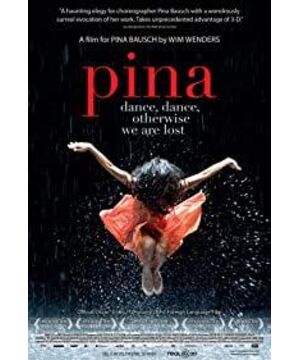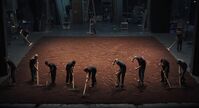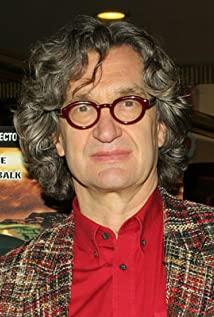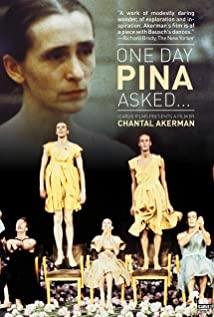Some people say that "Pina" is a documentary, some people say it is a biopic, some people call it a musical, and some people simply say: these are all wrong, "Pina" is a dance film. In fact, it is pointless to dwell on this issue too much. Because Wim Wenders doesn't give us much room to talk about Pina as a movie at all. The gritty fades and smooth camera movement clearly show his humility: a movie that honors the great Pina, not Pina that makes a great movie.
But his humility is not the same as mediocrity. It may be hard to imagine that 3D technology can come to life in a film that lacks the grandeur or visual impact, but Pina does it. It not only invites the audience into Pina's "dance theatre" and the streets and suburbs of Wupatal, Germany, but also builds another dimension beyond memory and reality. The audience sometimes sat in the auditorium of the theater, sometimes among the dancers, and sometimes looked at the dancers quietly, recalling the Pina who seemed to never leave. Arbitrary switching of perspectives connects and fuses stage, theater, reality, memories, and even different works, turning the originally independent time and space into a flowing river. But the reason why the audience is willing to drift freely on this river is not 3D technology, but Pina's dance itself.
As early as 1911, Italian film pioneer Giotto Canudo declared in the "Seventh Art Manifesto" that, in addition to architecture, music, painting, sculpture, poetry and dance, cinema is able to synthesize all these arts. And form the plastic art in movement, namely "the seventh art". Even so, neither Kanudu nor any moviegoer would think that all other arts are equally important to cinema. Take "poetry" (broadly) as an example, imagine what movies would be like without great novels and plays? To take this question to the extreme, what would a movie look like if there were no language for expressiveness? Ultimately, we will be asking the question: how can humans express themselves beyond language?
Before writing this review, I watched Pina four times over and over. I deeply feel that apart from poetry, no other form of writing can fully convey the spirit of Pina dance. But I can neither write poetry nor dance. In the end, I made the same choice as Wim Wenders: to give up the way I was accustomed to expressing myself, and humbly be a Pina listener. The dancers of the Wupatal Dance Company obviously did the same, and along with their reminiscence of Pina's words, there was a picture of them sitting silently. The body itself has infinite potential, so a real dancer can convey the most subtle or passionate emotions without words. Almost all of the troupe members spoke of how Pina could see into their souls only with her big, clear eyes. You don't hear serious long lectures in Upatar. One performer from The Rite of Spring put it this way: "Meeting Pina was like, finally, discovering a language I didn't know. Suddenly, she gave me a way to express myself without words...' Be wilder', this is the only opinion she has given me for twenty years." This "language without words" rejects the participation of rational judgment and logical reasoning, and any attempt to analyze and judge the Pina dance will attributed to failure.
Pina Bausch places special emphasis on dancers' self-expression and visceral emotional catharsis. A German dancer recalled Pina: "In front of her, all attempts at disguise disappeared. In fact, no one ever interpreted me like her." She famously said: "What I care about is why people move, rather than how to move", so she integrates dance and theater, sculpting and mobilizing dancers, she engages dancers in creation, and allows dancers to communicate personal experiences or ideas directly to the audience. She asked the dancers all kinds of questions, such as: "What would make you ashamed?" "Which part of the body do you like most?" "What would you do with a corpse?" Look at what's old, what's boring, what's fun. It's not improvisation, I'm trying to find what I know but can't put into words." something that comes out”, that is, her art transcends language. During the rehearsal of "Full Moon", she asked a dancer to tell her the meaning of joy. The dancer thought about it for a long time and made this answer: (Can't put the picture)
"Pina" is rarely seen in youth The handsome men and beautiful women, on the contrary, most of the actors have passed the age of confusion. In the older version of "Communication Field", some of the dancers are even ordinary people with simple training. The cherishing of each dancer's soul makes Pina's dance completely deny any superficial form, including the important factor of dance - the dancer's body. Because of this, the dance with body movements and expressions as the core transcends the particularity of the body and tells the life experience shared by all human beings: loneliness, fear, love, hurt, entanglement and freedom.
Wim Wenders should thank Pina, and movies should thank dance. Dance is a language that existed before humans invented language. When the dancers danced on stage, along the roads of Wupatar, near factories, in meadows and streams, their separation from the world around them seemed to disappear: escalators, beef, ballet shoes, water , sand, upside-down tram... In Pina, dance completely frees itself from its inherent definition and form, and becomes a pure expression. And this film featuring her also learned from Pina something higher than storytelling skills. The three main works "The Rite of Spring", "Vanity Fair" and "Full Moon" are the main frame of the film, interspersed with the video materials of Pina's death, the dance members' memories of Pina and their other works. In the flowing dance, the boundaries between time and space are becoming more and more blurred, and the gap between the image and the audience is becoming more and more shallow, and finally indistinguishable. So, where is Pina? Like her dance, Pina is equally indistinguishable from the dancers, the works, and even the audience. Perhaps, Pina lives on those borders. The pre-mortem video materials presented in 2D form clearly indicate her physical death, but in the interactive changes of triple or even quadruple space, the funeral lament has turned into a hymn of rebirth.
As the audience, we see not only the dance art of Pina or the film art of Wim Wenders, but also the heart-to-heart dialogue between the two masters. Unlike most biographical films, Pina Bausch, the protagonist of Pina, would have smiled with satisfaction if she saw the film made for her by a friend in heaven. One dancer said, "I've been trying to figure out why she's always working, working, working, working..." Wim Wenders apparently has the answer. At the end of the film, it is Pina's voice: "Dance, dance, otherwise we will lost. Dance, dance..." Dance is Pina's way of perceiving, thinking, expressing and releasing. And her works are not just about her own pain, love and hate, but belong to everyone.
"Pina" is probably the least biopic biopic. But it's definitely one of the best biopics out there. When Wim Wenders wrote "Pina", it was with infinite admiration, admiration and reminiscence for Pina. Compared with the piles of pseudo-biographical films full of sensuality and curiosity, it is undoubtedly much more serious and more valuable. Now that you have decided to tell the story of this person, why bother with the public's imagination of this person?
In any case, we should be grateful to Pina, who uses absurd scene settings to restore each real life situation, pierces our hypocrisy again and again with non-mechanical repetitions, and forces us to face our own souls.
View more about Pina reviews









